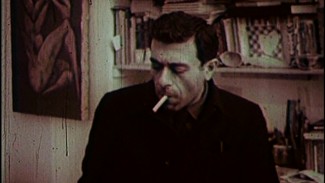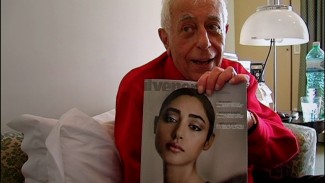INTERVIEW: ‘Fifi Howls From Happiness’ follows Bahman Mohassess’ final days

Director Mitra Farahani, whose new documentary Fifi Howls From Happiness opens Aug. 8 in New York City, tracked down infamous artist Bahman Mohassess to find out what happened after he left Iran. What she found was astonishing: The artist, a controversial figure in his homeland, was living in a Rome hotel room.
After being told about her desire to make a film, Mohassess let Farahani film his conversations on art and his rumination on the artistic themes of creation and destruction. The artist was so interested in the project that there are times in the film when he directs the director, telling her exactly how to showcase the scene in the movie.
Mohassess comes off as uncompromising and thoughtful, a man on the cutting edge of controversy and provocation. When Farahani films him talking to two art collectors interested in commissioning a painting, there’s a sense of exuberance and pending loss in the air. This may be the final time the artist will have the spotlight.
Fifi Howls From Happiness unearths Mohassess’ new life in Italy, but there is always a shadow hanging over his words, perhaps a longing to remember his days in Iran.
Recently Hollywood Soapbox exchanged emails with Farahani. Answers have been slightly edited for style.
How did you find the story of Bahman Mohassess, and how did you find him living in Rome?
The story of Bahman Mohassess was known to most Iranians who at least have heard about art and literature. It’s not his symbolic importance, acknowledgement or fame that was lacking but his physical presence. He would always be referred to rather as a myth or a living legend than an actually existing person. This has to do with the fact that he wasn’t showing himself that much or at any cost; he often remained in his intimate circles and relations, leaving Teheran once in a while for Rome, etc. It was mainly his almost “aristocratic” attitude, leading him to tear apart from society both intellectually and physically, living as an enlightened and iconoclastic outsider, who would explode some of the most conservative taboos and social conventions — but always in high praise of history and cultural heritage at the same. As for the question how I “found” him, a good investigator never reveals his/her sources. Too unfaithful…

What is your theory on why the artist destroyed so much of his work?
He truly considered himself as the “creator” who had the right of life and death on his almost-living “creatures”. It could be turned as simply as that. Indeed his birds and fishes for example, stand for symbols of a greater threat, often of ecological catastrophe. But he used to put it in the same way, for political downfalls that he also represented. He used to ask: “What could be the meaning of painting anymore, in a world with a sky devoid of birds, a sea devoid of fishes and a wood devoid of beasts?”. In front of all that violence Mohassess’ answer of course was not self-destruction, for the course of his life showed him harshly struggling with those issues, in a positive attitude. But certainly the end of his life, the choice of self-exile and symbolic retirement, all the violence in the world that profoundly disgusted him, all contributed to a more violent answer to violence. Destruction progressively becoming a part of it.
In the film, the artist likes to give you direction on how to tell the story. Were you surprised by this? Did you feel obligated to follow his instructions?
I feel there was no other path for the film to eventually exist, than having Mohassess’ constant recommendations and “film directions” — integrated and put forward. Not only because it “allowed” me to do this impossible film on an impossible character reflecting on his potentially impossible chef d’oeuvre. But mainly because Mohassess was a man of power, at every stage of his life, embodying, counterbalancing, addressing or fighting power. Therefore I was certainly not surprised and I praised those instructions as part of the process. They were revealing to me, that I would never do “my” film on someone’s life, that I would innocently have interpreted or so. But I was only helping the last chapter of an already begun movie, to become archived and visible, a movie begun long ago, without me. The movie of the collective ignorance which leads us to forget and dismiss our greatest spirits, a movie in which Bahman Mohassess was the main protagonist (giving his film instructions).
What is it about Bahman Mohassess’ work that inspires you? Do you have a favorite among his pieces?
The Lying Minotaur (currently on display at Musée d’art moderne in Paris) is among my favorites because it’s such a symbol for defeat or decay of the sumptuous and beauty, in a world contaminated by the tragedy of mankind afterwards World War II. And also a collage entitled La Risata (the one who laughs) that is among the most beautiful to me. She seems to shout in endless pain and still we are advised that she’s laughing (to death probably) but in her naive pastel colors and false innocence of greenish and pinky. Not to say a word of Fifi obviously, who is close to my heart, but in a way more part of the myth than history. All his work with an overtly committed attitude touch me (against Vietnam War, the murder of Martin Luther King, the massacre of My Lai, the famine in Africa…)
Do you believe the artist would be happy with the final film?
Hard to say. Mohassess was so unpredictable … At least he would be happy that his incendiary quotes but also firm beliefs and harsh ethics still cause effects on those hearing them. Anyway, provocation was not the latest of his pleasures.
What happened to the two who commissioned his final painting? Was their money returned?
They returned home in Dubai with the small sculptures and the Fifi painting that were promised to them by written act from Mohassess.
By John Soltes / Publisher / John@HollywoodSoapbox.com
-
Fifi Howls From Happiness open in New York Aug. 8 and Los Angeles Aug. 15.

